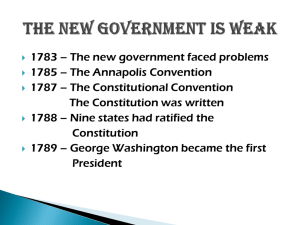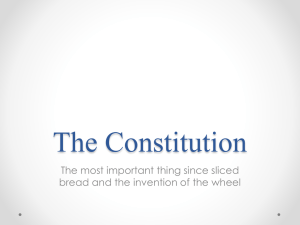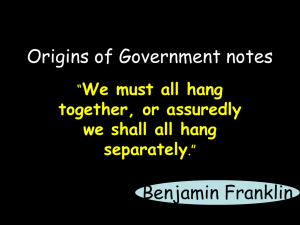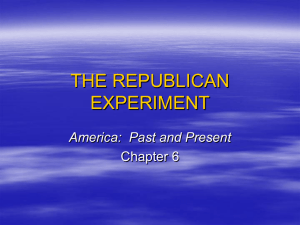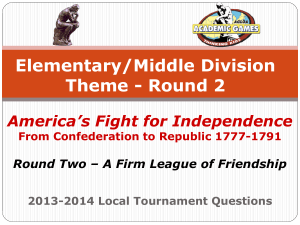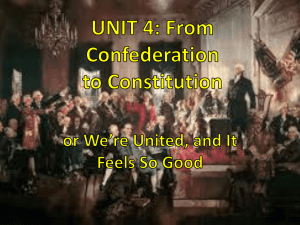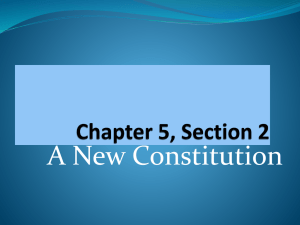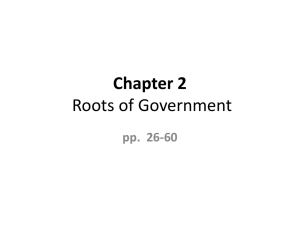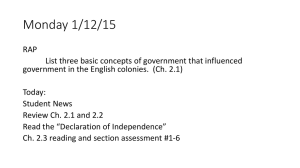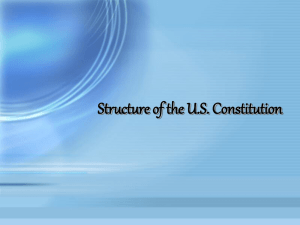The Creation and Ratification of the Constitution
advertisement
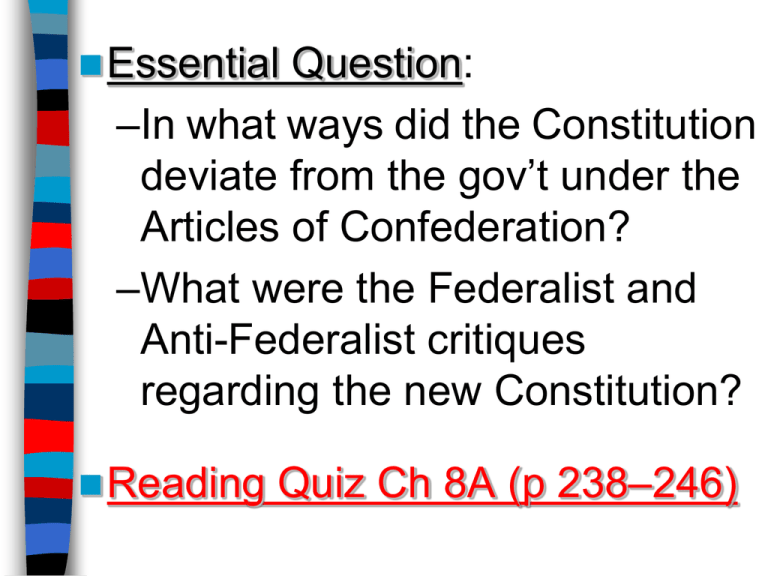
Essential Question: –In what ways did the Constitution deviate from the gov’t under the Articles of Confederation? –What were the Federalist and Anti-Federalist critiques regarding the new Constitution? Reading Quiz Ch 8A (p 238–246) Constitutional Reform Thus, American political ideology states created weak state governors & a weakfrom Articles Confederation changed theofbeginning of the American Revolution to theoflate The problem is an excess democracy not period: an excess of tyranny Confederation –InShays’ the 1770s, American political Rebellion will help prove this pointsaw to the Founding leaders tyranny asFathers the greatest threat to the USA –But…by the mid-1780s, they saw ordinary citizens who lacked virtue as the greatest threat Congress did not Merchants in MA hired Constitutional Reform have the tax funds their own mercenary Byan 1787, fatal to flaws of uprising the to send army themilitia end the Articles of Confed were exposed: –Shays’ Rebellion broke out among desperate MA farmers who faced losing their farms or being sent to debtor’s prison –Congress called for a meeting Shays’ Rebellion gave nationalists like in In Sept 1786,Madison, James Madison ledthe Washington, Hamilton Philadelphia to discuss revising the Annapolis Convention to urgency to call for a stronger national gov’t the Articles & strengthening the discuss improving American trade national gov’t The Constitutional Convention in Philadelphia, 1787 The Philadelphia Convention Shays Rebellion led to increased support for a stronger central They did NOT intendattendance to government & more at replace the Articles the Philadelphia Convention In May 1787, 55 delegates from all states (except RI) met to discuss revising the Articles of Confederation, but it soon became apparent that something more serious was needed The Philadelphia Is this a governmentConvention of the people? Convention Philadelphia delegates inTo Philadelphia madeall3 amend the Articles, 13 statesdecisions: had to agree important (& illegal) –The Articles of Confederation were to be completely replaced –Nothing from the meeting was to be printed or spoken to the public –Every state got 1 vote but all decisions needed a majority vote (not 9 of 13 states) to pass The Inventing a Federal Republic Delegates incorporated 4 major principles into this new gov’t: –Limited gov’t—even though a stronger gov’t was being created, citizens’ liberty is protected –Republicanism—the people vote for their leaders –Separation of powers—three branches with defined powers –Federalism—the national gov’t shares power with state gov’ts Three Branches of Government Federalism Inventing a Federal Republic Madison William Paterson presented the presented the Virginia Plan: SmallNew statesJersey objectedPlan: to –Congress given –Bicameral this large-state dominance power to tax legislature –Each state had –Larger states The large states one vote in a had more listened politely then unicameral representatives overwhelmingly legislature voted against it –Create a chief –But Articles executive mostly appointed by untouched Congress James known as the TheAlso Great Compromise “Connecticut” Compromise” Roger Sherman helped resolve Victory for the small the differences between the states large & small states Victorybyforproposing large states the Great Compromise Only the House of Reps –Congresscould would be a bicameral introduce tax bills legislature (House & Senate) –Each state was given 2 delegates in the Senate –House of Representatives was determined by state population What did Congress look like after the Great Compromise? The 3/5 Compromise Problems still remained between the northern & southern states regarding how to count population size (do slaves count?) The Three-Fifths Compromise settled the issue: –Three-fifths of the slave population could be counted toward representation in the House of Representatives Compromising with Slavery Despite the contradiction slavery posed, Southerners threatened to leave the USA anytime the slave question was discussed As a compromise for the South, the slave trade could continue to 1808 & runaway slaves returned “Great as the evil is, a dismemberment of the Union would be worse.” —James Madison The Last Details Including ideas tyrannical: In 1787, a once finalconsidered draft included: Presidential power to appoint judges & –Electoral College to vote for the presidential veto power over Congress president to “filter the masses” –System of checks & balances among the 3 branches of gov’t –President would serve for 4 years rather than for life Delegates decided against a Bill of Rights because most state constitutions already had them FYI: Electoral Votes (2000 Census) James Madison helped broker many of the compromises that made the Constitution possible & is referred to as the “father of the Constitution” Only Congress can of make Key Ideas thelaws, Constitution declare war, create taxes The “elastic clause” gives Congress implied powers to make laws seen as “necessary & proper” The Senate ratifies treaties & confirms judicial appointments Key Ideas of the Constitution The president can only recommend legislation to Congress but can veto bills The president oversees the bureaucracy Key Ideas of the Constitution The only court mentioned in the Constitution is the Supreme Court Federalism—state gov’ts & the national gov’t both have power The supremacy clause establishes the Constitution (not the states) as the "the supreme law of the land" A state law cannot contradict a national law The Struggle for Ratification The Struggle for Ratification The delegates in Philadelphia knew that ratification of the new Constitution would not be easy: –They had no authority to change the Articles of Confederation –They did not inform the public of their ongoing decisions –They fundamentally altered the relationships between the states & the central government Federalists & Anti-Federalists Federalists Anti-Federalists Supported Against ratification ratification of the –Distrusted of a Constitution Authored by that Madison, gov’t Were wellHamilton, & Jay removed power Anti-Federalists argued organized & from the hands for more protection of educated individual liberties of the people Used Federalist –Claimed the new Papers to argue “The Constitution is for ratification itselfConstitution a Bill of Rights” favored the Had the support upper class of the media Ratification of the Constitution Adding the Bill of Rights To win ratification, theRevolution… Federalists If1776 was the 1st American 1787 was the 2nd American agreed to add a Bill ofRevolution Rights – With this protection of citizens’ liberty, all 13 states agreed to ratify the Constitution – Constitution became the official the law of the land in 1789 After bitter fight, most Americans chose to support the Constitution Discussion Question Which of the following ideas was most important to the framers of the Constitution in 1787? –Federalism –Separation of powers? –Checks and balances? –Republican democracy? –Gov’t limited by the people? Which is most important today?
